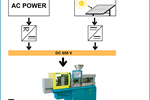Electric Injection Molding Machine Line Expands
Boy will debut three new models in its Electric series of machines, which feature a redesigned and more compact drive and inverter technology.

The Boy 35 Electric, Boy 50 Electric and Boy 80 Electric injection molding machines will debut at Fakuma 2024. Source: Boy Machines
German injection molding machine maker Dr. Boy GmbH & Co. KG is presenting three new models of its Electric series presses at Fakuma. The Boy 35 Electric, Boy 50 Electric and Boy 80 Electric injection molding machines feature clamping forces ranging from 35 to 80 tons. Promising precision and efficiency typically associated with all-electric machines, the Electric series’ drives for injection and dosing, as well as the ejector, are electromechanically designed.
Boy filed a patent application for the machine’s use of dynamic pressure measurement on the injection mechanism via a strain sensor. Boy says the electromechanical drive enables precise positioning, dynamic motion and shorter cycles because of the parallel clamping force structure for injection.
The two-platen clamp, which is servo-hydraulically powered, is combined with an electromechanical ejector for a oil- and lubricant-free mold installation space.
The new ejector provides more dynamic, precise travel, as well as parallel movements without a double pump, which can shorten cycle times and protect molded parts, the tool and robotics. The compact low-maintenance Output Signal Switching Device (OSSD) maximizes safety. Boy says the option to actively brake the screw movement and recover energy for subsequent movements is also available.
At Fakuma, Boy is presenting six machines at its booth, ranging in clamp force from 10 to 125 tons, with another six machines operating at partner booths. Boy’s largest machine — the 125-ton model with a 5.22-m² footprint — will use a BOY 2C S auxiliary injection unit for making two-component ice cube molds, featuring a hard/soft material combination.
Related Content
-
Got Streaks or Black Specs? Here’s How to Find and Fix Them
Determining the source of streaking or contamination in your molded parts is a critical step in perfecting your purging procedures ultimately saving you time and money.
-
Process Monitoring or Production Monitoring — Why Not Both?
Molders looking to both monitor an injection molding process effectively and manage production can definitely do both with tools available today, but the question is how best to tackle these twin challenges.
-
Back to Basics on Mold Venting (Part 2: Shape, Dimensions, Details)
Here’s how to get the most out of your stationary mold vents.








